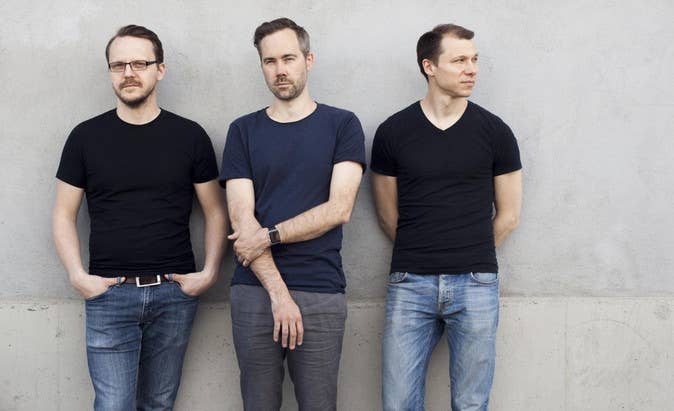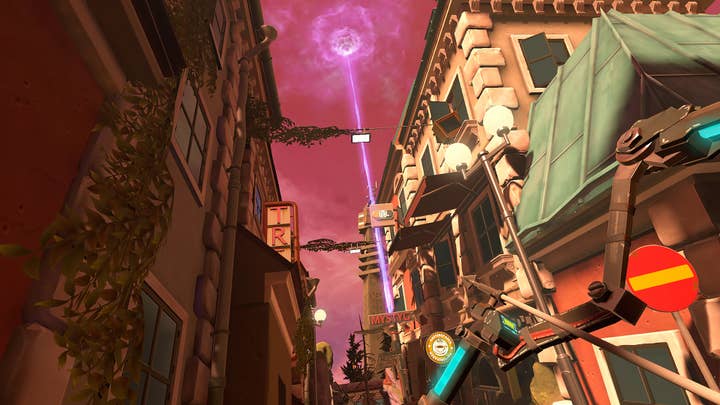Fast Travel Games: "Think long and hard on free locomotion in VR"
Once seen as carrying too high a risk of motion sickness, Erik Odeldahl now believes that free movement in VR is too popular to leave out
VR developers must think "long and hard" about implementing free locomotion in first-person games. According to Fast Travel Games co-founder Erik Odeldahl, while free movement is the surest way to make most players nauseous, there is a large and growing number of players who won't buy a VR game with any other control system.
Odeldahl formed Fast Travel Games in 2016 with two colleagues (see image below) from EA DICE, where he worked on Battlefield, Medal of Honor, and ultimately served as design director for Mirror's Edge Catalyst. Speaking at the Nordic Game Conference recently, Odeldahl told the audience that the company's founding ambition was to use that decade at one of the leading AAA studios to bring something new to the nascent market for VR games.
Specifically, Fast Travel was intended to be a high-end VR studio working with, "any VR headset with proper, six degrees of freedom controllers, so we can simulate hands," Odeldahl said, adding that Oculus Rift (with Touch controllers) and HTC Vive were "where we set the bar" in terms of user experience. The studio's first game, Apex Construct, was pitched a first-person adventure, with gameplay divided equally between exploration and combat. It would be substantial, too, with a six-hour campaign at a time when the market was dominated by, "fifteen minute experiences - some of them awesome, but really short experiences."
"We said that everybody - every single person that puts on a headset - should be able to play it"
That level of ambition wasn't common in VR at the time, and it demanded that Apex Construct be accessible to as wide an audience as possible. As such, Fast Travel decreed to launch on Rift, Vive and PSVR as close together as possible, but the desire to reach everybody also had implications for design. In simple terms, in order to make a VR game for everyone, it was necessary to avoid the risk of triggering motion sickness in users.
"We said that everybody - every single person that puts on a headset - should be able to play it," Odeldahl told the NGC audience. "That doesn't mean it should be an easy game; it's actually a physical thing. If you do things wrong in VR, people will get sick. We said everybody should be able to play our game, and that means we support sitting gameplay, standing gameplay, and room-scale gameplay."
But that stance also meant leaving one kind of gameplay out: free locomotion, a method of navigating 3D space that approximated the freedom of using a thumbstick. The allure of free locomotion is obvious, but it is also the simplest way to trigger motion sickness in the user, due to the clash between body position and what the brain perceives as the 'reality' of first-person movement in the virtual world. The high risk of nausea it carries is the reason so many VR experiences are seated, or use abstract solutions like teleportation to navigate space.
"Early on we decided to build a game that didn't support free locomotion," Odeldahl said. "It is something that exposes a lot of people to motion sickness. If you implement this badly a lot of people will feel ill."

Fast Travel opted to use teleportation as the primary method of locomotion - a popular choice among developers of first-person VR games. Production started in March 2016, and Apex Construct remained a teleportation game until November 2017; Paris Games Week, where it was revealed by Sony as part of a marketing deal that would make it exclusive to PlayStation VR for the first month.
"We got lots of good response," Odeldahl recalled of the game's debut in Paris. "But lots of players said, 'If this game doesn't support free locomotion, I won't buy it. Period.'"
This hardline stance over what was widely regarded as a risky control system came as a surprise. Apex Construct was due to launch on PSVR in February 2018, less than four months later, with the PC version scheduled to follow in March. And yet despite extensive user-testing, this was the first time that free locomotion had been suggested as anything other than a risk to player enjoyment.
"Lots of players said, 'If this game doesn't support free locomotion, I won't buy it. Period'"
"In the VR landscape things change super quickly right now," Odeldahl said. "We playtested the game a lot, and not a single one of our testers said anything about free locomotion... When you playtest, people will often respond to what is in the game and not necessarily to what is missing. If we had asked people afterwards if they missed free locomotion, they would probably have said yes. We should have studied this way more carefully."
With the PSVR release looming, Fast Travel decided to heed the feedback from Paris Games Week and add free locomotion - albeit what Odeldahl admitted was a single, imperfect implementation. When Apex Construct launched the response was largely positive, with some strong reviews from both critics and users. However, "most of the people that complained, complained about our shitty free locomotion in the game."
Even with an extra month to fix the key issues for the PC version - and Odeldahl spoke of the confidence his team had in having done a fine job of exactly that - Apex Construct's positive user reviews were still counterbalanced by those who felt shortchanged by the game's implementation of free locomotion.
"There was this wonderful question," Odeldahl recalled. "'Why is it so hard for VR devs to implement conventional, smooth trackpad locomotion?' But it turned out that every person writing to us had their own idea of what 'conventional locomotion' is. Every single one. There just isn't a standard. It's like console first-person shooters before Halo.
"What we ended up doing - and what a lot of VR developers are now doing - was to support several different options for free locomotion, so the player can decide for themselves."

Even with all of these adjustments to the original plan, Fast Travel still believed that the people who so vocally and vehemently argued for free locomotion represented a very small portion of the game's audience. When Odeldahl pulled the numbers for how people chose to play, he expected to see that one or two per cent had done so with free locomotion.
"In my opinion, it doesn't matter [how many people use it]," he said. "It could be one per cent. But because of the small userbase in VR right now, and a lot of people being very vocal online, I would argue that you have to support it anyway.
"It's a mind-bogglingly large percentage. Half the players of our game use free locomotion"
"Luckily, the numbers we're seeing are just way, way higher than we thought they would be. It turns out that, across all of the platforms we released on, 46 per cent played the game using free locomotion. It's a mind-bogglingly large percentage. Half the players of our game use free locomotion.
"The people that voice their opinion online, who gave us the one and two star reviews, they were not a vocal minority... When you see angry voices online, if you're a VR developer, check your numbers."
The high usage of free locomotion could be an outcome of an idea known as "VR legs", which suggests that people develop a tolerance for the discordant experiences that trigger nausea over time. Had Fast Travel launched Apex Construct with free locomotion back in March 2016 - when production first began - that usage number may well have been one or two per cent. However, Odeldahl reminded the audience that only one person on the Fast Travel team could play the game in its entirety with free locomotion even now - everyone else feels sick at some point.
"I can't do it," he admitted. "Some people will never ever get 'better' at VR. We as developers will get better at implementing better control methods, the hardware will get better - there's tons of stuff happening, and I'm 100 per cent sure that this puzzle will get solved, but it's not there yet.
"You can't believe people who say that everybody will get their VR legs. At least in a game like ours, you need to support teleportation as well. It can't only be a free locomotion game, because you will have a large user-base who will not be able to play."
For Fast Travel Games, though, the parameters of what constitutes an 'accessible' VR experience now includes free locomotion as standard - and not just one form, but a variety of implementations to suit a range of tastes and tolerances. Indeed, the studio's next game will be built with that in mind from the very start.
"We're thinking about this from the get-go this time," he said. "After release we supported one type of free locomotion scheme, and now we support several. If there's one lesson I want you to take away it's this: if you're building a VR game where people move around a lot, think long and hard on free locomotion."
GamesIndustry.biz is a media partner of the Nordic Game Conference. We attended the show with assistance from the organiser.
